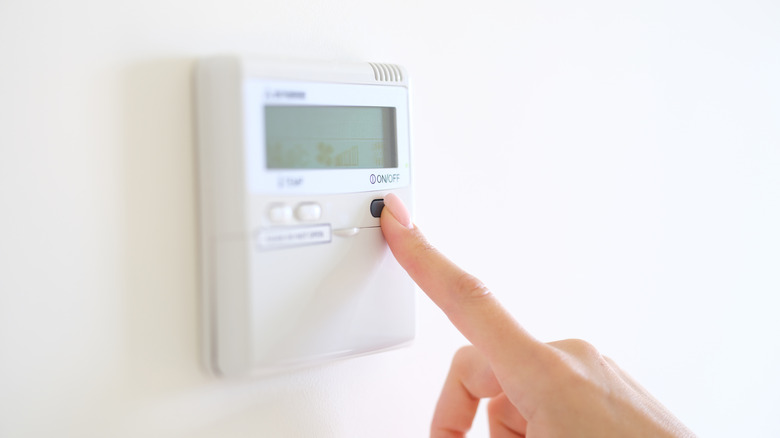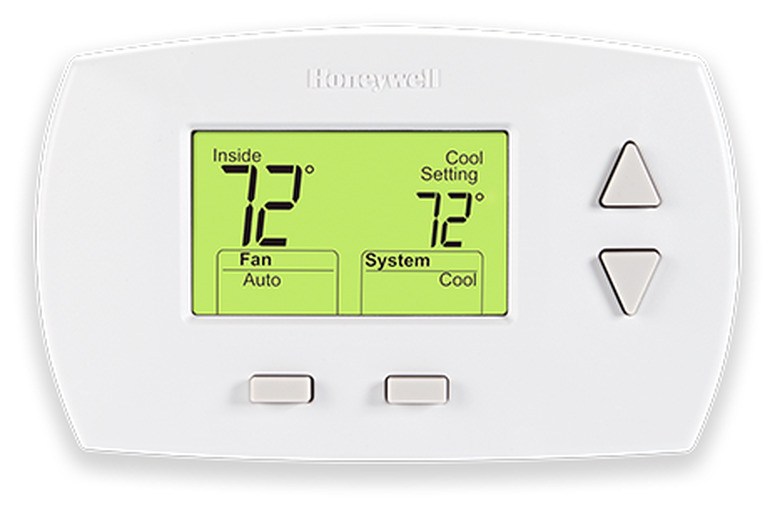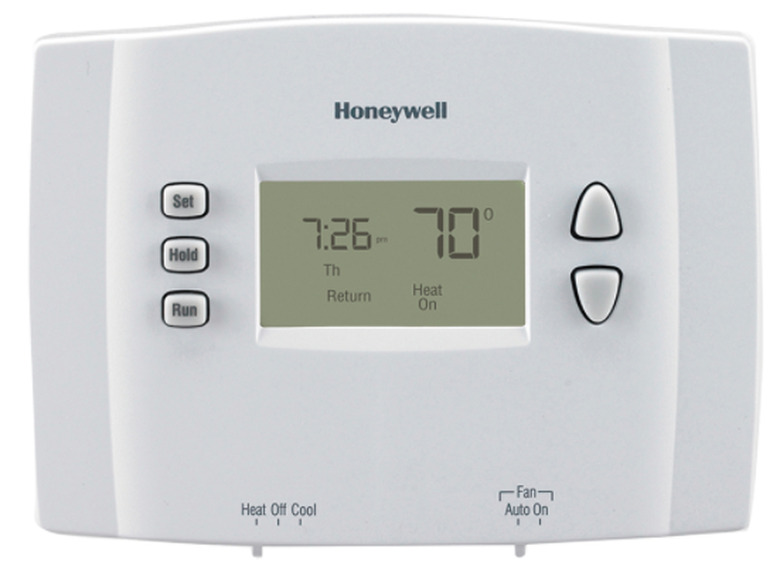How To Program A Honeywell Thermostat
We may receive a commission on purchases made from links.
Whether you're a homeowner or a renter, it's important to know how to program a Honeywell thermostat if you want to get the maximum use from it. As the leading maker of thermostats, Honeywell offers dozens of different models ranging from very simple styles that allow you to set a single automated program that's the same every day to elaborate touch-screen models that make it possible to set a different group of automatic temperature adjustments for each day of the week.
In addition, you might have a Honeywell smart thermostat, and it pays to become familiar with the added functionality and the ability to program it remotely via Wi-Fi using one of the Honeywell Home family of apps. Operating your particular thermostat model may seem like rocket science, but it's worth learning to do it because it allows you to optimize the use of your HVAC system. Here, for example, is one of many perks: By automating the process of turning down the temperature at night or when you're away from the house, you can enjoy energy bill reductions that range from 10 to 30 percent.
Identifying Honeywell Programmable Thermostats
Identifying Honeywell Programmable Thermostats
While a great many (maybe most) thermostats made by Honeywell are now digital programmable models, there are still simple models that allow you to raise, lower, and set temperatures without any automation. The range of options makes it easier to find the right thermostat for your home, but determining if yours is actually a Honeywell programmable thermostat isn't always easy.
For many Honeywell thermostats, the presence of a Prog, Set, or Menu button is the giveaway that the digital thermostat is programmable. Those that aren't programmable have nothing to set, so they're missing this button. The photos here show the difference between a typical nonprogrammable thermostat and one that can be programmed.
On the very latest digital models, you may find no buttons at all. Instead, there is a touch-screen feature in which you'll read the Set command on the screen itself.
Tip
A word about terminology: A thermostat labeled as "one week" programmable means that there is only one program you can set, and each day of the week will follow the same pattern of temperature adjustments. If you have a "5-2 day" programmable thermostat, you can program it for two separate cycles: one for the five-day workweek and another for the two-day weekend. If the thermostat is labeled "5-1-1" programmable, there are three programs possible: one for weekdays, one for Saturday, and another for Sunday. Finally, "7-Day Program" means that each day of the week can be programmed individually.
Here are some popular Honeywell thermostat models and their functions. This is by no means an exhaustive list, but it does demonstrate the diversity available. It's likely that your home thermostat is closely related to one of these:
Nonprogrammable Thermostat Models
- Honeywell Pro 5000 series (TH5110D, TH5320U, TH5220D): Nonprogrammable thermostats with a digital screen.
- Honeywell RTH5100B: A premium nonprogrammable thermostat with a digital screen.
- Honeywell RTH221B: A basic one-week programmable thermostat offering one program.
- Honeywell RTHL2310B: A basic 5-2 thermostat offering two programs.
- Honeywell TH6110D1005/U FocusPro 6000: A 5-2 thermostat with an extra-large backlit screen.
- Honeywell RTH6450D: A 5-1-1 thermostat offering three programs.
- Honeywell RTH2510B1018: A 7-day programmable thermostat with a digital screen.
- Honeywell RTH7560E: A 7-day programmable model with touch-screen controls.
- Honeywell RTH8580WF: A 7-day programmable model with Wi-Fi connectivity.
Honeywell Smart Thermostats
- Honeywell RTH9585WF: A 7-day programmable Wi-Fi thermostat with touch screen and Energy Star certification.
- Honeywell TH8321WF1001: Also known as the Vision Pro 8000. Features multistage capability for a furnace, air conditioner, or heat pump.
- Honeywell TH6220WF2006/U Lyric T6 Pro: Another in the Honeywell Pro series. Multistage capability and compatible with Amazon Alexa.
- Honeywell Home T9: Can be configured with multiple temperature sensors for climate control in individual rooms.
Programming a Honeywell Thermostat
Programming a Honeywell Thermostat
Because there are many variations in thermostat styles, it's impossible to describe the programming process for each and every one of them. However, whether old-school or next-generation, they all follow much the same process, so it should be an easy matter to interpret the following thermostat instructions even if your model doesn't exactly match.
These instructions are based on the Honeywell RTH6450D1009 5-1-1 thermostat, but virtually all Honeywell thermostats are programmed using a process that's similar if not identical.
Tip
The first step in any programming, whether you recently replaced your thermostat or just never programmed it from the start, is to make sure the time and date are set correctly. If they're not, there is no way to program a schedule of temperature settings.
1. Set the Time
Push the SET button until the time or day display begins to flash on the screen. Then, use the arrow buttons to adjust the time up or down until the correct time of day is displayed. Press the DONE button to lock this time into the thermostat.
On some thermostats, pressing the SET key a second time is what locks the time into the thermostat.
2. Set the First Program
- Press the SET key and then press the key labeled SET SCHEDULE. (On some thermostats, you press the SET key several times to toggle through the various functions on the thermostat.)
- Press the UP/DOWN arrow keys until the display flashes to the MON-FRIDAY WAKE display. Then, press NEXT.
- Use the UP/DOWN arrow keys to set the time you typically wake up during the Monday-to-Friday workweek. When the proper time is set, press NEXT.
- Use the UP/DOWN arrow keys to set the desired temperature for the wake-up time for that day of the week. When the correct temperature is displayed, press the NEXT button to lock in that temperature and move on to the next time period.
- Use the UP/DOWN arrow keys and the NEXT button to lock in times and then temperatures for the remaining three periods of the program: Leave, Return, and Sleep. This four-temperature program is standard on most programmable thermostats.
3. Set the Next Program
Upon locking in the last temperature period for Monday to Friday, pressing the NEXT key will activate the next program available on your thermostat. For our thermostat, this is the Saturday program. Program this in the same fashion (see step 2 above) and repeat until all programs are set. This may be only one additional program for a 5-2 thermostat or as many as six more for a 7-day thermostat model.
4. Complete the Program and Make Adjustments
Press the DONE button to lock in the program and close the setup menu. If you've made an error in the initial programming or if your schedule changes and you need to adjust the program, the process is simple:
Press the SET SCHEDULE button and then toggle through the menu options by using the NEXT button and UP/DOWN arrow keys to toggle through the functions and make new settings. For example, let's imagine that you want to change both the start time and the temperature for that time of day. The key press sequence would look like this:
- SET CLOCK/DAY/SCHEDULE.
- UP or DOWN arrow keys until WAKE period begins to flash on the screen.
- UP or DOWN arrow keys until the new wake time you desire is displayed.
- NEXT.
- UP or DOWN arrow keys until the desired temperature is displayed.
- DONE (on some models, you may need to toggle through the other time periods and programs before the DONE key displays).
5. Override the Program (as Needed)
What happens if you stay home from work some day, for example, and want the thermostat program to keep the heat on rather than sending the temperature down to 60 degrees? Just press the arrow keys until the desired temperature is displayed on the screen. Your thermostat will display the word TEMPORARY on the screen, and the thermostat will then hold the temperature at that level until the next time the schedule changes and takes back control of your system. At the point where you want to resume the program, just hit the RUN SCHEDULE button.
Another way to override the program is to use the permanent hold feature, which will tell the thermostat to hold the temperature at the current level until you deactivate it. The procedure to activate this feature varies, so check your user manual.
How to Set Up and Program a Honeywell Smart Thermostat
How to Set Up and Program a Honeywell Smart Thermostat
Honeywell provides a programming tutorial on its website for each smart thermostat model it sells, and you can also find the information in the user manual for that model. For a Pro series thermostat or any other Wi-Fi-enabled model, you need to connect it to your router. After you've done that, you can operate it from your laptop or mobile device using a Honeywell app.
The setup begins only after installation and thermostat wiring are complete because the unit gets its power from the HVAC transformer via the common wire, or C-wire. Make sure the circuit breaker is on and the display screen is illuminated.
1. Complete the Initial Setup Sequence
- Select the language you prefer from the menu, then press NEXT.
- Select whether the system is for a home or a business, then press NEXT.
- Key in a name for the thermostat using the keypad on the screen if one appears. Otherwise, use the UP or DOWN buttons to select the letters. Press NEXT.
- Select whether the thermostat controls a heating system, a cooling system, or both. Press NEXT.
- Select whether the thermostat controls a forced-air system, a heat pump, or a hot water or steam system. Press NEXT.
2. Enter Your Wi-Fi Credentials
When the prompt appears asking whether you want to connect to a Wi-Fi network, choose YES. Select your network from the menu that appears. Enter your Wi-Fi password. You can find it on the front, back, or bottom of your router. It's called the wireless key (WPA).
3. Register Your Thermostat
Write down the two numbers that appear on the next screen — the thermostat MAC and CRC (similar to the model number and serial number) — which identify your thermostat. These numbers are also printed on the back of the thermostat. Visit mytotalconnectcomfort.com, set up an account with a username and password, and then enter these numbers to register your device. This account helps subscribers with troubleshooting problems.
4. Install the App
Install the Resideo app on your laptop or mobile device and then open it and follow the prompts to find your thermostat. You can now do DIY programming remotely following the guidance in the app. Depending on the thermostat, you can also control the air conditioning or turn the heat on and off using the touch screen. If you need help with a specific model, instructional videos are available on the Honeywell website or on YouTube. Be sure to watch the full video to get the most energy-saving value from your thermostat to save money.


